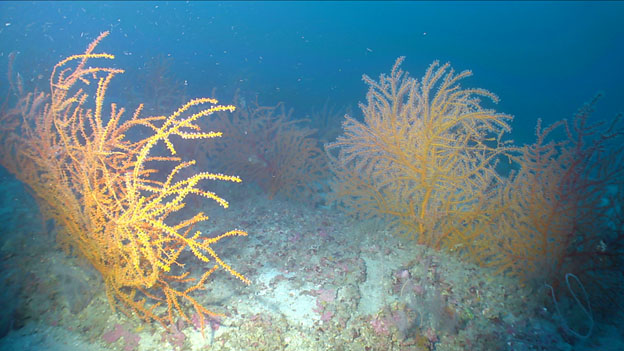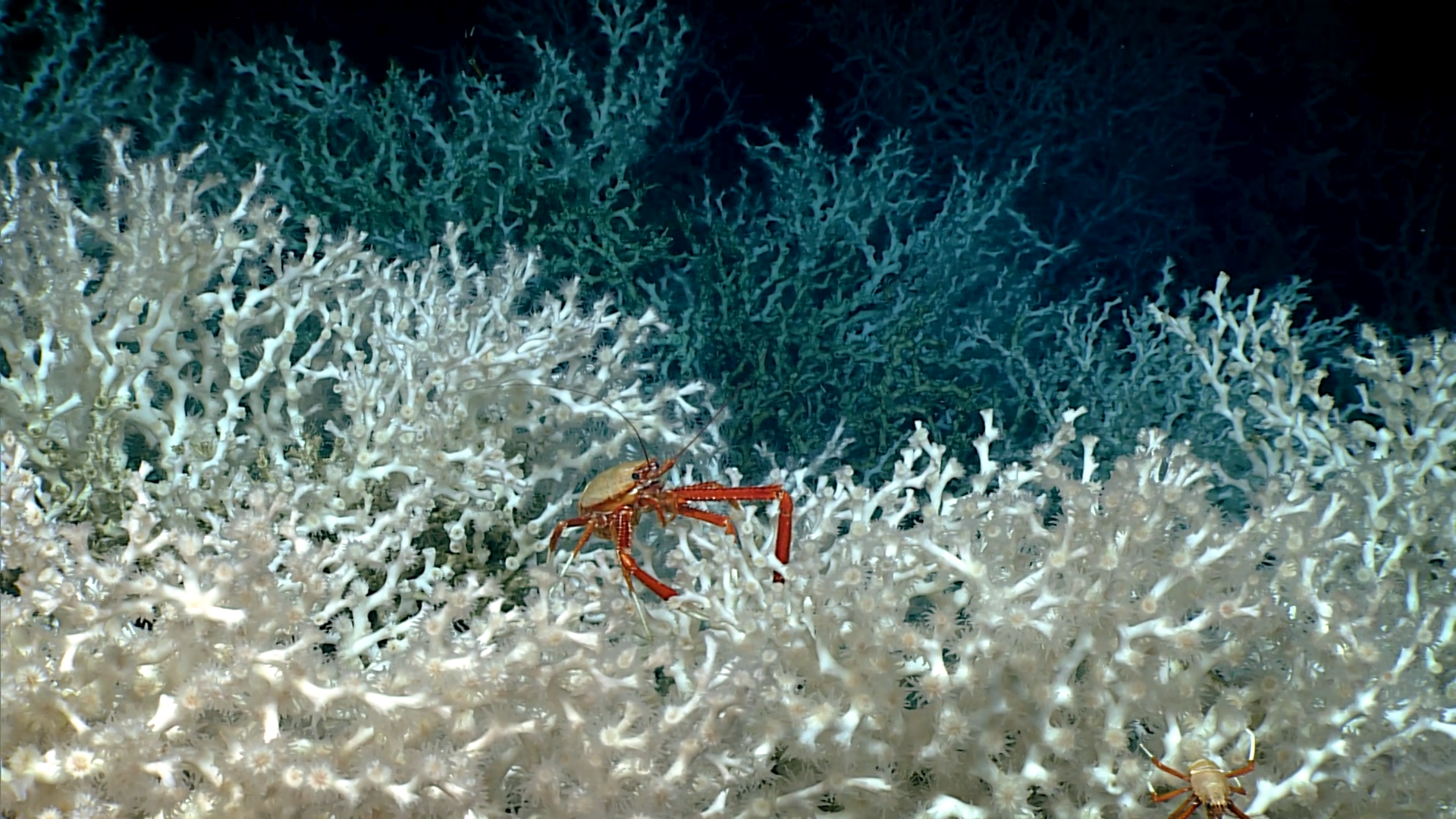We are working on a collaborative set of projects to better understand and restore mesophotic and deep benthic communities in the Gulf of America (formerly Gulf of Mexico) impacted by the 2010 Deepwater Horizon oil spill. These projects focus on seafloor mapping, ground-truthing, habitat modeling, and coral propagation.

Why We Care
Mesophotic and deep benthic communities (MDBC) in the Gulf of America are complex ecosystems spread across vast areas of the ocean floor. While seemingly isolated, they are the foundation for a series of interconnected food webs throughout the Gulf.
On April 20, 2010, the Deepwater Horizon mobile drilling unit exploded, resulting in a massive release of oil from the BP Exploration and Production Inc. (BP) Macondo well, causing loss of life and extensive natural resource injuries. Oil spread from the deep ocean to the surface and nearshore environment from Texas to Florida. Extensive response actions tried to reduce harm to people and the environment. However, many of these response actions had collateral impacts on the environment and on natural resource services. More than 770 square miles of deep-sea habitat and four square miles of mesophotic habitat were injured by the Deepwater Horizon oil spill.
In 2016, the DWH Trustees reached a settlement with BP to resolve BP’s liability for natural resource injuries from the DWH oil spill. Under this settlement, BP will pay the Trustees up to $8.8 billion to conduct restoration as described in their Final Programmatic Damage Assessment and Restoration Plan.
The DWH Open Ocean Trustee Implementation Group selected four projects to enhance the management, protection, and restoration of MDBC in their 2019 Final Restoration Plan 2 and Environmental Assessment. The projects include: 1) Mapping, Ground-truthing, and Predictive Habitat Modeling, 2) Habitat Assessment and Evaluation, 3) Coral Propagation Technique Development and, 4) Active Management and Protection.
The projects include an initial one- to two-year planning and design stage, followed by a five-year field and lab-based implementation stage, and one year for final evaluation and reporting. An important aspect of the planning and design stage will be to ensure transparency in decision-making and effective approaches for stakeholder engagement, public input, and sharing data and project results over time. NCCOS scientists are co-leads for the mapping, habitat assessment, and coral propagation projects and play a significant role in the planning and implementation for all the MDBC projects, including the active management and protection project.
Mesophotic and Deep Benthic Community Restoration goals are:
-
- Restore mesophotic and deep benthic invertebrate and fish abundance and biomass for injured species, focusing on high-density mesophotic and deep water coral sites and other priority hard-ground areas to provide a continuum of healthy habitats from the coast to offshore.
- Actively manage valuable mesophotic and deep-sea communities to protect against multiple threats and provide a framework for monitoring, education, and outreach.
- Improve understanding of mesophotic and deep-sea communities to inform better management and ensure resiliency.

What We Are Doing
NCCOS scientists are co-leading three of the four MDBC projects in cooperation with the NOAA Restoration Center. The objectives of each MDBC project include:
Mapping Ground-truthing and Predictive Habitat Modeling
-
- Map (e.g., high-resolution surveying, backscatter interpretation, and photomosaic assemblage) and ground-truth (i.e., visually and including sample collections) MDBC at sufficiently high-resolution for habitat characterization, and to refine predictive models to improve the effectiveness and cost efficiency of restoration and mapping efforts.
- Document the abundance and distribution of deep benthic communities.
- Provide fundamental information to prioritize and support protection and management activities and to target locations for direct restoration.
Habitat Assessment and Evaluation
-
- Fill critical data gaps and evaluate sites for potential direct restoration activities, including protection, as well as reference sites associated with the placement of coral fragments and substrates.
- Document ongoing injury to MDBC from natural and anthropogenic threats.
- Provide the background data needed to detect and quantify potential future impacts in other locations and to assess success of restoration efforts with respect to recovery, natural mortality, and growth rates.
- Establish a baseline for health and condition to guide direct restoration and protection of these ecosystems.
Coral Propagation Technique Development
-
- Develop methods and techniques for effective enhancement of coral recruitment and growth and the application of successful methods at a large scale for restoration.
- Directly compensate the loss of MDBC corals and associated benthic and water column communities injured by the Deepwater Horizon oil spill.
Active Management and Protection
-
- Manage and protect MDBCs from known threats.
- Conduct protected area management activities to achieve restoration goals identified in the Deepwater Horizon Programmatic Restoration Plan, help maintain ecological integrity, and increase ecosystem resilience.
The MDBC project teams are planning for implementation activities that will begin in 2022. Planning activities include comprehensive literature and data inventories for mapping, ground-truthing and modeling and the habitat assessment teams, identification of external partners for planning and implementation, and planning for field work.
Benefits of Our Work
We anticipate filling many informational gaps in our understanding of mesophotic and deep benthic communities. As a result we will have the ability to directly restore coral colonies and provide information that can help manage and protect these sensitive habitats.
Next Steps
Field work for 2022 will consist of a mapping cruise on NOAA Ship Hassler (April/May) and joining mapping and habitat assessment cruises on NOAA Ships Pisces (July) and Nancy Foster (August). Two cruises are planned in the Flower Garden Banks region with the R/V Manta to collect live coral colonies for husbandry, and study reproduction strategies of deep-water octocorals. Mission plans are in development.
A network of partner aquaria and lab facilities is forming to meet the challenge of large-scale, deepwater restoration. Cold water aquaria are under construction at three federal labs around the Southeast region: the Hollings Marine Lab in Charleston, SC; the Wetlands Aquatic Resources Center in Gainesville, FL; and the Fort Crockett Laboratory in Galveston, TX. The labs are testing pilot systems and new propagation techniques, and will refine them with partners as the project grows.
Collaborators
NOAA and the Department of the Interior, including USGS scientists, are leading project implementation and expect to engage and work with other federal agencies, state agencies, academia, NGOs, and the private sector.
